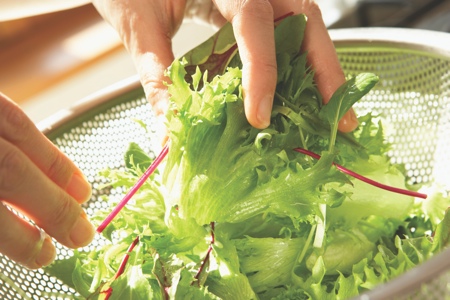Just as you can train muscles to cope with more exercise challenges, it is similarly possible to increase the body’s organs’ resilience to environmental challenges such as metabolic and immunological stress. Different plant-based foods play an important role in this ‘organ training’ and an understanding of how this mechanism operates will enable the development of improved foods and, ultimately, of personalised diets that will keep us within our own ‘health space.’
It is increasingly apparent that you are literally what you eat and what you have eaten. Almost all the cells in the body contain the complete genome, but how it’s used is tightly regulated by cell-specific and environmental factors. By using the new generation of sequencing tools, we have been able to look with high resolution at how and which part of the genome is expressed in a given cell.
Our previous studies suggest that to keep the genome flexible and responsive, it is important to eat a range of foods, with findings indicating that a diverse diet may reduce the loss of function that comes with age. We have found that some foods are particularly good at ‘exercising’ the genome. For example, work at the Institute of Food Research has shown that plant foods such as broccoli are able to increase the protective and metabolic capacity of the cells. Other studies are shedding new knowledge on the body’s response to other dietary components, such as fats.
The cells in the body can cope with a certain amount of saturated fats if their metabolic capacity is sufficiently adapted to handle them. Unfortunately, in the West, we overeat foods with too much saturated fat and, in particular, with added sugars that can be converted into saturated fats — and this means our organs are chronically overloaded and unable to cope.
By chronically overloading our organs one by one, they will lose their metabolic plasticity
An important organ such as the liver has some overcapacity if it’s lean and healthy; but, with more and more liver fat (steatosis), the liver has a reduced metabolic capacity. By chronically overloading our organs one by one, they will lose their metabolic plasticity. From a local organ-related problem, a systemic problem slowly develops. It is a chain reaction with a series of consecutive events that take time (months to years) until complex diseases such as diabetes emerge.
Such complex multicausal diseases cannot be easily cured. The only real solution is a more efficient prevention of this disease at a stage when processes are still reversible and people can return to health.
Health as a continuum
Most healthy organs operate at 30–50% capacity, but if you lose the adaptive response, the body becomes vulnerable to diseases. It would therefore be more useful to think of health as a continuum from very healthy to very ill, with a ‘pre-disease’ phase when early detection would prevent the further development of the increasingly irreversible pathological part of illness.
This leads us to redefine the definition of health as the ‘optimised ability of an individual to adapt to immunometabolic challenges’. This allows a more dynamic exploration of health, rather than the traditional static approach of ‘not ill.’ It also means that health is quite personal because this ability to adapt to various challenges is different from man to woman, from child to adult or elderly and, ultimately, from person to person.
Early intervention
We do not have a good understanding yet of this ‘pre-disease’ phase when the body is slowly losing its resilience capacity to stay within its health space (healthy boundaries). As individuals, we are also out of touch with our bodies and often dismiss these early symptoms by saying, “I am a bit tired, but I am not ill enough to do anything about it”. Without taking action, it may become too late and then a strong pharmacological treatment is required that might cause other side-effects and start a downward spiral.
We do not have a good understanding yet of this ‘pre-disease’ phase when the body is slowly losing its resilience capacity to stay within its health space
A different approach would be to develop an ‘organ function test’ that could quantify the responses to challenges: with a high-calorie drink or meal, for example, before and after an intervention with healthy foods or lifestyle changes. This would provide an estimate of organ capacity and how much of this can be improved by a healthy diet that is rich in plant foods.
If too many calories are the problem (related to overweight or obesity), intervention strategies that lead to a severe reduction in calorie intake should be applied. This strategy has been shown to delay the progression of type II diabetes, suggesting that early dietary modification and lifestyle changes could also have wider benefits for other illnesses.
Designing healthy food
The gastrointestinal system plays a vital role in regulating the body’s metabolic activity. It has developed during evolution for diets rich in plant material, which is hard to digest and low in calories. With primitive diets, we had to eat more to get sufficient calories. So the 6–8 metres of the gut has a huge surface area which, because of its special microvilli structure, is highly absorptive and extremely efficient at keeping all the energy extracted from the food in the body and not losing it in the stool.
Food moving slowly through the intestines is continuously screened by sensing mechanisms for energy and nutrient content and, by reaching the more distal part of the gut, it triggers the release of gut hormones that signal to the organs of the body to prepare them for action. It will also interact with all the intestinal microbiota that form an increasingly recognised essential component of our body. We believe that a high diversity of microbes, supported by a diverse plant food rich diet, is an essential requirement for a healthy gut.

This all works well for more traditional Mediterranean diets, for example, but less so for typical Western diets that are rich in highly processed foods with a diluted protein content, added sugar, easily digestible starch and saturated fat. The result of the rapid digestion and resorption in the upper part of the small intestine is a reduced satiety signal produced in the intestine, which results in a huge influx of glucose and fructose to the blood that goes straight to the liver. In addition, the overconsumption of carbohydrates that are not absorbed in the small intestine may result in health problems in the large intestine by decreasing the microbiota diversity (dysbiosis), gas production and related disorders of the gut.
A comprehensive knowledge of the intestine will also allow us to help food manufacturers to design foods that are more appropriate for organ needs. I am not advocating a return to the ‘old foods’ of our ancestors (paleo foods) but, instead, the development of modern ‘slow’ foods that trigger a healthy response by the organs. Understanding gut function and its interaction with food is essential to promote good health; and here, on the Norwich Research Park, we have a huge opportunity to provide this know-how in collaborative projects with the industry.
The Food and Health Alliance
We are opening up the secrets of the huge power of nutrition, which has a subtle regulating effect on the body and is identifying healthy foods that trigger, for example, the chemoprotective response. There is never just one receptor that is triggered but many receptors, the response is not zero to one hundred per cent but more gradual, so the interaction is complex. You can compare it to the degree of control provided by a music console in contrast to a simple light switch with only an on/off mode as an option.
It is true that if we don’t use it, we lose it. Ageing is a process wherein the genome becomes less accessible, hidden in the chromatin structures by various epigenetic processes, not responding as it did in the past. Although it is important to start early with good nutrition, it should be recognised that it is never too late, just harder in later life.

Unlike the early genomic tools, with which you had to look gene-by-gene to see the impact, it is now possible to take a genomic snapshot of everything in one experiment. Not only can we start to look at all the 20,000 human genes in one go, but also to take an unbiased view of cellular responses. We will also look at the complex changes in the gut microbiota and their relationship with human health. This integrated analysis allows us to take an objective view and discover new things, unlike the traditional hypothesis-driven approach to research that starts with a preconceived idea of what might be happening.
On the Norwich Research Park, we are very well placed to do this work with multidisciplinary experts at the Institute of Food Research (IFR), John Innes Centre, the UEA with its different expertise groups, the large Norfolk and Norwich University Hospital (NNUH) and The Genome Analysis Centre (TGAC), with the technology and the bioinformatics expertise to deal with the analysis and integration of big data. All these resources will be drawn together within the Food and Health Alliance.
I am particularly excited about the announcement (May 2014) of plans for a new Centre for Food and Health Research here on the Norwich Research Park, demonstrating that we have the right momentum for this research. I see the Food and Health Alliance as having a number of stakeholders with research being of interest to:
- consumers and those that advise consumers on healthy eating by increasing understanding of the interaction between health and nutrition and the benefits of new types of foods
- clinicians to provide better diagnostics and enable improved dietary advice, perhaps within the early stages to halt disease progression
- companies wanting to establish health claims for particular foods or to develop food products with beneficial effects
It is not possible to be world-leading in all organs, but the gut, as the primary organ to deal with foods, is at the centre of the body and all other organs relate to this, so our work on the Norwich Research Park is directed at understanding this first gatekeeper.




